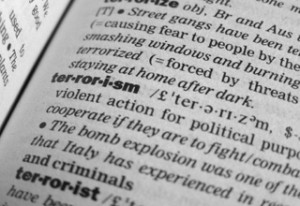Ask yourself this question: what are the first images that come to mind when you think of a terrorist? I was asked this question not too long ago and was shocked by the first pictures which flashed through my mind. My shallow response was a person that could be comparable to Osama bin Laden: typically male, with a substantial beard, donning a thawb (traditional robe garment), and fashioned in a keffiyeh (traditional headdress now commonly identified as a scarf). Or even just an Arab looking man wearing camouflage. I would be surprised but very pleased if you thought differently. However, if you were asked this question about 20 years ago, the predominant image would probably be of an Irish guerrilla fighter – back when images of terrorists were typically associated with the Irish Republican Army. I was 9 when September 11 occurred, the images I saw that day and subsequently all those which followed, steered towards that sort of stereotype – and that becomes hard to cast away. Through television programmes, movies, magazines, and newspapers, the 21st Century image of a terrorist persists and when any ‘terrorist’ attack occurs around the world, the first suspects at the scene are identified through a typical but arbitrary lens: someone that looks like they could be from the Middle East.
But let’s flip this around a bit. How about asking yourselves these questions: is the real terrorist a person? Are individuals and non-state groups really the enemy? Non-state terrorism causes a great deal of strife in society, but state actions can be just as harmful, posing real threats to each and every one of us – can states be the real terrorists?
Terrorism: A Troubled Term
September 11 shaped the way we define terrorism in the 21st Century, typically terrorism is now seen as a threat which is made up of loosely linked, non-state networks, carried out by amateurs, motivated by ‘nihilist’ objectives with a disregard for political aims, and set on mass casualties through indiscriminate selections. However, it becomes interesting if one traces back to the original use of the word terrorism – it once referred to the violence committed by the Jacobin government on the French population, it was used as a term to prosecute Nazi actions and domination in Europe in the Nuremberg Trials, and historians have described Josef Stalin’s rule during the Soviet era as terrorism. Originally, terrorism was used to describe a tool of state governance exercised on the population, but it has transformed to describe acts committed by non-state entities against the state.
But even with the all the hype surrounding terrorism, a definition cannot be agreed upon in academia or in the policy making world. Many diplomatic attempts have been made to establish a universal understanding of the term which has failed in reaching a consensus. There have been 109 definitions proposed between the years 1931 and 1981, with still no success in creating a general meaning that all states can agree on. The overarching legal framework for counterterrorism since the Global War on Terror was declared – the United Nations Security Council Resolution 1373 – bypasses defining the concept of terrorism and fails to identify the specific meaning of terrorists. It states that “such acts, like any act of international terrorism, constitute a threat to international peace and security”. Ambiguity allows states to be flexible in their actions, and they will of course adopt a definition of terrorism which suits their needs – a non-state interpretation.
However, it is important to know that another side of the story exists. Terrorism should be seen as a form of political communication – an intentional and pre-determined strategy of political violence which is intended to cause fear and intimidate its audience. An interpretation which includes a variety of actors, such as states.
You’re more likely to Drown in a Bathtub than Perish at the Hands of a Terrorist
So, let’s put the threat of non-state terrorism in perspective:
“The number of Americans killed by international terrorism since the late 1960s is about the same as the number killed over the same period by lightning or by accident-causing deer. In almost all years the total number of people worldwide who die at the hands of international terrorists is not much more than the number who drown in bathtubs in the United States”.
“In 2010, 13,186 people died in terrorist attacks worldwide; in that same year, in America alone, 31,672 people lost their lives in gun-related deaths” and even more shocking, in 2013, pre-school children with guns have taken more lives in America than terrorist attacks – just one occurring in Boston.
On a global scale, an estimated 1000 – 7000 deaths are caused by terrorism a year, but compare this to the 40,000 who die from starvation each day, the 500,000 who are killed by light weapons each year and the annual 2.9 million deaths caused by HIV-AIDS.
Heck, you’re more likely to die from hospital errors, DIY accidents or alcohol poisoning than getting caught up in a terrorist plot! Once things are put in perspective, the terrorist threat becomes minimal. So why does society continue to worry? The amount of terrorism states have committed and continue to commit is what we should be most afraid of. It is the reaction to these terrorist attacks which is most terrifying and in reality, non-state terrorism actually grows out of state actions and policies.

The events of 9/11 shocked people worldwide. They were highly visible and instilled fear in society.
An Uncertain State of Mind
With the stats presented above, why do states place so much importance on combating terrorists? The answer lies partly in underlying symbolism and meaning. The attack on 9/11 was framed as an attack on American values, which soon turned into an attack on Western values, and finally spiralling to threatening civilisation as we know it. Terrorism placed state sovereignty and the stability of the international system in danger. The event shocked and damaged people psychologically worldwide. Terrorist attacks are used as a type of political communication: they are highly visible, the tactics used are graphic in nature, and the fact that attacks seem to be random, instils fear in society. The appearance of a random act occurring can make the risk seem radically larger even though statistically, the chances of being caught up in a terrorist act are minimal. The terrorist also wants to convey a message to the public that they are disposable – not only does terrorism threaten your life, it threatens your value, morally. We require reassurance and security from threats that are highly visible even though the ones less visible, such as diseases, are greater threats to our lives.
The threat of terrorism has become embedded in the way we talk, the way we act, the way we live. After 9/11, “out of fear, many people cancelled airline trips and consequently travelled more by automobile than by airline after the event, and one study has concluded that over one thousand people died in automobile accidents in 2001 alone between September 11 and December 31 because of this”. This was a substantial increase in fatalities from the previous year.
The state has capitalised on public fear and mistrust, enabling it to enforce radical measures to counter non-state terrorism. Fear then triggers hatred and provokes ignorance. The terrorist becomes transformed into something less than human, into ‘the other’. This view further perpetuates ethnic and racial stereotyping which only increases the suspicion of already insecure people. The threat and fear of terrorism has become implanted in our language and value systems which only fuels the cycle of violence further.
Let’s Just Bomb Them: The Disproportionate Measures of Retaliation
The reactions to non-state terrorism by states have been disproportionate to the actions themselves. For example, after the bombing of American embassies in Africa in 1998, killing 200 civilians, Clinton’s bombing retaliation on suspect pharmaceutical factories and suspect training camps may have led to the deaths of tens of thousands of Sudanese over the course of the campaigns. After 9/11 occurred, the US attempted to counter terrorism by attacking other states – creating two wars in Afghanistan and Iraq – in order to reduce casualties on their own soil. However, Western involvement and of course the people of Afghanistan and Iraq, have paid a high price as the number of non-combatant and combatant deaths in these wars has been much higher than in all the terrorist attacks combined. Measures of so called ‘counterterrorism’ have caused more casualties than the terrorists themselves – what do we make of this? Well that’s a question you can continue to ponder about.
The Complexity, Improbability and Ridiculousness of WMD
Another huge concern seems to be surrounding terrorism and the chances of terrorist attacks incorporating biological or chemical weaponry, or even using Weapons of Mass Destruction (WMD). Even though of course, this threat is possible, it is logically improbable. “Thirty years of field research have taught observers of terrorism a most important lesson: terrorists wish to convince us that they are capable of striking from anywhere at any time, but there really is no chaos”. There are fairly logical reasons why these weapons have a small chance of ever being utilised by terrorists: if such technology was used to kill masses of people, the chances of their political aims being recognised would be slim – they would be less likely to gain sympathy from the public for their cause. Terrorists also know that if they were to set off a nuclear bomb, the retaliation from states worldwide would be immense, threatening the very existence of their groups and networks. Terrorists are not stupid, they are aware that the creation and release of biological weapons have consequences that are not known – again with the risk of creating a weapon that can threaten their lives and their cause. Non-state terrorists want people watching, want people scared, and wish to politically benefit from their actions.

Each counterterrorist policy put in place by individual governments has its own benefactors which feed off this industry. People’s livelihoods now depend on this industry which makes it difficult to remove altogether.
State Terrorism and You: What You Can Do To Combat It
If the goal of terrorism is to create insecurity, fear, anxiety and hysteria – this can be defeated simply by not being terrified and resisting temptation to overreact. Fear-mongering and the effects of retaliation bring me to the conclusion that ultimately, we are only victims if we let terrorism influence us. You can try blame politicians, academics, corporations and the media for perpetuating the way terrorism is portrayed in this modern day and age – but in the end, politics and power is shaped by us – the consumer. If we believe the threat is everywhere, then we must spend our money everywhere to prevent the threat, which further perpetuates the terrorist as an all-seeing, all-knowing being. We consume fear and legitimise the goals and wishes of those in charge. The truth is, fear and hysteria sells – and without these products, the key ingredients for control and shock policies start to crumble. So stop buying into fear.
Not only has terrorism created a culture of hysteria and paranoia, but it has had effects on the world economy – in and of itself – your own pocket. Who knows how much money has actually been spent globally to fund counterterrorist programmes; to fund weapons; to develop technology. But each counterterrorist policy put in place by individual governments has its own benefactors which feed off this industry. People’s livelihoods now depend on this industry which makes it difficult to remove altogether – think about the new jobs created in sectors such as security and technology… Imagine the chaotic surge in unemployment if this was to all disappear.
What is fairly certain to claim however, is that the money spent on military measures has redirected resources away from crucial sectors of society. Imagine if the trillions of dollars were placed into areas of health, education and welfare – if even part of that sum was placed into scientific research, maybe we would have the capabilities to find the cure for cancer? Of course that’s just a speculation, but the fact that 100,000 people a year die from hospital infections and another 100,000 people a year die from preventable medical errors in the United States really does indicate a need to protect citizens in terms of health, rather than terrorism. The economy is entrenched in state terrorism practices used to pursue unachievable but politically popular goals of domestic security – the terrorists have managed to redirect money away from sectors which matter in our lives. ‘We must not let the terrorists win’ is the sort of phrase we hear from our world leaders, but I think we have already let them triumph.
What I’ve tried to do is to get you to think about terrorism differently, to consider a different argument. Society perspectives are transformative and terrorism only matters in a big way if we let it matter.
So if someone ever asks you what a terrorist looks like… What will you say?
Find more articles by Sandra here
Related articles in the category Terrorism


Trackbacks / Pings